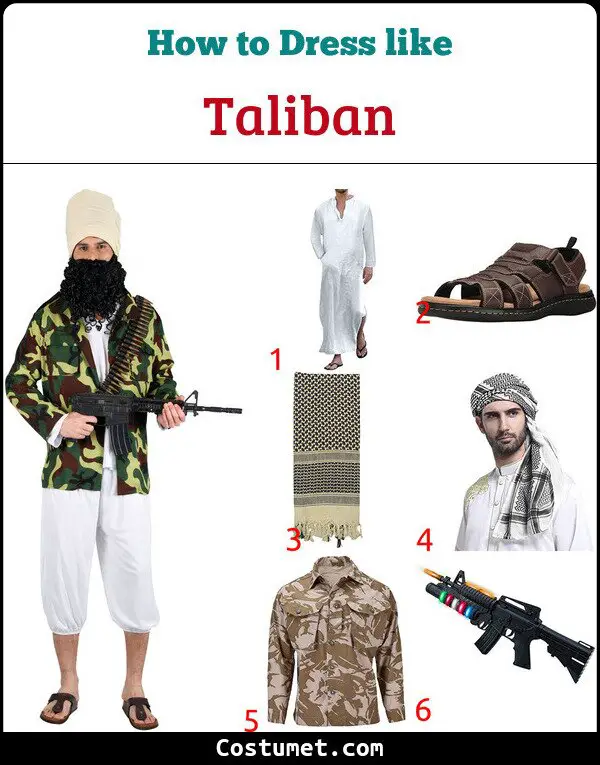Taliban Costume for Halloween
How to Make Taliban Costume

| # | Item | Description |
|---|---|---|
| 1 | White Long Sleeve Kaftan Long Gown | Start off your Arab warlord getup with this white long-sleeved kaftan gown. |
| 2 | Brown Fisherman Sandal | Be able to move easily even on sandy terrain with these brown fisherman sandals. |
| 3 | Tactical Desert Scarf | Protect your face from the desert elements as well as from unwanted prying eyes by using this tactical desert scarf. |
| 4 | Arab Headscarf | Regulate the effects of the hot and cold temperature around you by having this Arab headscarf. |
| 5 | Army Desert Lightweight Jacket | Add protection and comfort to your body by also wearing this army desert lightweight jacket. |
| 6 | Armalite Rifle | Use this electronic armalite rifle toy as props. |
The Taliban is an Islamic fundamentalist and nationalist militant political movement in Afghanistan which ruled most of the country from 1996 to 2001, until being overthrown after the US invasion. They launched an insurgency against the US-backed Islamic Republic of Afghanistan since then, and have immediately returned to power in 2021 after the US and coalition forces left the country.
Taliban means “student” in Arabic. To look a part of the Taliban, you will need to wear a long-sleeved white kaftan gown, brown fisherman sandals, a tactical desert scarf, an Arab headscarf, and an army desert lightweight jacket.
About Taliban
The Taliban is an Islamist extremist group that originated in the early 1990s in Afghanistan. The group’s ideology is based on a strict interpretation of Islamic law known as Shariah. During their rule from 1996 to 2001, they enforced a harsh form of governance in Afghanistan, implementing strict social and religious codes.
Under Taliban rule, women faced severe restrictions on their rights and freedoms, including limited access to education and employment opportunities, mandatory dress codes such as the burqa, and restrictions on movement. The Taliban also imposed strict punishments, including public executions and amputations, for violating their version of Islamic law.
Following the September 11 attacks in the United States in 2001, the Taliban came under international scrutiny for harboring Osama bin Laden, the leader of Al-Qaeda. In response, a U.S.-led coalition invaded Afghanistan with the goal of removing the Taliban from power and dismantling terrorist networks in the region.
Although initially driven out of power, the Taliban regrouped over time and began an insurgency against foreign forces and the Afghan government. This led to years of conflict and instability in Afghanistan.
In recent years, there have been attempts at finding a political resolution to the conflict. In February 2020, the United States signed an agreement with the Taliban outlining a framework for peace talks and setting a timeline for foreign troop withdrawal from Afghanistan.
It is worth noting that while some regional countries have supported or tolerated elements within or connected to the Taliban due to various reasons such as geopolitics or historical alliances, there has been significant international concern about their treatment of human rights—particularly regarding women’s rights—and affiliation with terrorist organizations.
The situation remains complex and fluid, with ongoing efforts to establish lasting peace and stability in Afghanistan. It is essential to recognize that discussions about these topics should be approached with sensitivity and respect for different perspectives given their political nature and potential impact on people’s lives.
The Taliban enforces a very strict interpretation of Sharia, or Islamic law, and is notorious for being repressive to its women, with policies that include banning women from holding almost any jobs, requiring women to wear head-to-toe coverings such as the burqa, blocking women from travelling without male guardians, and banning all education for girls.
Check out these sites to learn more about the Taliban:





